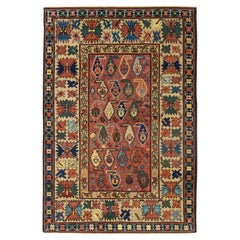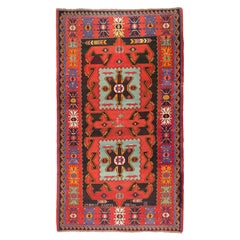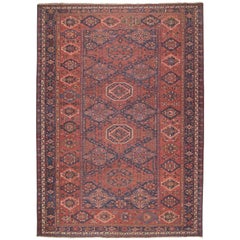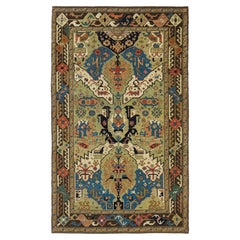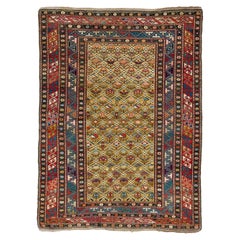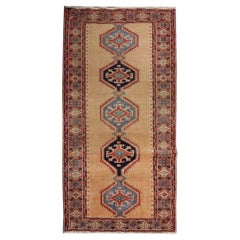Hand-Woven Caucasian Rugs
21st Century and Contemporary Turkish Revival Hand-Woven Caucasian Rugs
Wool, Natural Fiber, Organic Material
Mid-20th Century Caucasian Kilim Hand-Woven Caucasian Rugs
Wool, Natural Fiber
Late 19th Century Azerbaijani Sumak Antique Hand-Woven Caucasian Rugs
Wool
21st Century and Contemporary Caucasian Oushak Hand-Woven Caucasian Rugs
Wool, Organic Material, Natural Fiber
Late 19th Century Caucasian Kazak Antique Hand-Woven Caucasian Rugs
Wool
1930s Caucasian Kazak Vintage Hand-Woven Caucasian Rugs
Wool, Cotton, Organic Material
Late 19th Century Caucasian Kilim Antique Hand-Woven Caucasian Rugs
Wool, Natural Fiber
Late 19th Century Caucasian Tribal Antique Hand-Woven Caucasian Rugs
Wool
1940s Armenian Kilim Vintage Hand-Woven Caucasian Rugs
Wool, Cotton, Organic Material
Early 20th Century Azerbaijani Minimalist Hand-Woven Caucasian Rugs
Wool
Late 19th Century Caucasian Oushak Antique Hand-Woven Caucasian Rugs
Wool, Natural Fiber, Organic Material
21st Century and Contemporary Caucasian Revival Hand-Woven Caucasian Rugs
Wool, Natural Fiber, Organic Material
Late 19th Century Tribal Antique Hand-Woven Caucasian Rugs
Wool
1890s Caucasian Sumak Antique Hand-Woven Caucasian Rugs
Wool
Late 19th Century Caucasian Antique Hand-Woven Caucasian Rugs
Wool
21st Century and Contemporary Caucasian Revival Hand-Woven Caucasian Rugs
Organic Material, Natural Fiber, Wool
1950s Caucasian Vintage Hand-Woven Caucasian Rugs
Wool
21st Century and Contemporary Turkish Revival Hand-Woven Caucasian Rugs
Wool, Organic Material, Natural Fiber
Late 19th Century Turkish Oushak Antique Hand-Woven Caucasian Rugs
Wool, Natural Fiber, Organic Material
1920s Caucasian Sumak Vintage Hand-Woven Caucasian Rugs
Wool
21st Century and Contemporary Turkish Revival Hand-Woven Caucasian Rugs
Wool, Natural Fiber, Organic Material
19th Century Caucasian Kazak Antique Hand-Woven Caucasian Rugs
Wool
Early 20th Century Caucasian Kilim Hand-Woven Caucasian Rugs
Wool, Natural Fiber
21st Century and Contemporary Turkish Revival Hand-Woven Caucasian Rugs
Wool, Natural Fiber, Organic Material
1960s Azerbaijani Kilim Vintage Hand-Woven Caucasian Rugs
Wool, Cotton, Natural Fiber, Organic Material
21st Century and Contemporary Turkish Revival Hand-Woven Caucasian Rugs
Wool, Natural Fiber, Organic Material
Mid-19th Century Persian Tribal Antique Hand-Woven Caucasian Rugs
Wool
21st Century and Contemporary Turkish Revival Hand-Woven Caucasian Rugs
Wool, Natural Fiber, Organic Material
Early 20th Century Caucasian Oushak Hand-Woven Caucasian Rugs
Wool, Natural Fiber
1860s Armenian Kazak Antique Hand-Woven Caucasian Rugs
Wool
21st Century and Contemporary Turkish Revival Hand-Woven Caucasian Rugs
Wool, Natural Fiber, Organic Material
20th Century Caucasian British Colonial Hand-Woven Caucasian Rugs
Wool
21st Century and Contemporary Turkish Revival Hand-Woven Caucasian Rugs
Wool, Natural Fiber, Organic Material
1860s Armenian Antique Hand-Woven Caucasian Rugs
Cotton
Late 19th Century Caucasian Tribal Antique Hand-Woven Caucasian Rugs
Wool
Early 20th Century Caucasian Kilim Hand-Woven Caucasian Rugs
Natural Fiber, Wool
21st Century and Contemporary Turkish Revival Hand-Woven Caucasian Rugs
Wool, Natural Fiber, Organic Material
19th Century Caucasian Antique Hand-Woven Caucasian Rugs
Wool
Early 20th Century Caucasian Tribal Hand-Woven Caucasian Rugs
Wool
21st Century and Contemporary Turkish Revival Hand-Woven Caucasian Rugs
Wool, Natural Fiber, Organic Material
21st Century and Contemporary Turkish Revival Hand-Woven Caucasian Rugs
Wool, Natural Fiber, Organic Material
Early 20th Century Caucasian Kazak Hand-Woven Caucasian Rugs
Wool
Late 19th Century Armenian Antique Hand-Woven Caucasian Rugs
Wool
1970s Asian Kilim Vintage Hand-Woven Caucasian Rugs
Wool, Cotton, Organic Material
Mid-20th Century Caucasian Kilim Hand-Woven Caucasian Rugs
Natural Fiber, Wool
21st Century and Contemporary Turkish Revival Hand-Woven Caucasian Rugs
Wool, Natural Fiber, Organic Material
21st Century and Contemporary Turkish Revival Hand-Woven Caucasian Rugs
Wool, Natural Fiber, Organic Material
Mid-19th Century Caucasian Kilim Antique Hand-Woven Caucasian Rugs
Wool, Natural Fiber
21st Century and Contemporary Turkish Revival Hand-Woven Caucasian Rugs
Wool, Organic Material, Natural Fiber
Late 20th Century Asian Sumak Hand-Woven Caucasian Rugs
Wool
Late 19th Century Caucasian Antique Hand-Woven Caucasian Rugs
Wool
21st Century and Contemporary Turkish Revival Hand-Woven Caucasian Rugs
Wool, Natural Fiber, Organic Material
Mid-20th Century Caucasian Kilim Hand-Woven Caucasian Rugs
Natural Fiber, Wool
Early 20th Century Caucasian Kazak Hand-Woven Caucasian Rugs
Wool
Early 20th Century Caucasian Tribal Hand-Woven Caucasian Rugs
Wool
Mid-20th Century Russian Kazak Hand-Woven Caucasian Rugs
Wool
Late 19th Century Caucasian Kazak Antique Hand-Woven Caucasian Rugs
Wool
1990s Afghan Kazak Hand-Woven Caucasian Rugs
Wool, Cotton, Natural Fiber, Organic Material
Early 1900s Caucasian Kazak Antique Hand-Woven Caucasian Rugs
Wool
Early 20th Century Caucasian Kazak Hand-Woven Caucasian Rugs
Wool
